The Deprivation of Liberty Safeguards and Mental Capacity Act 2005
VerifiedAdded on 2023/01/10
|20
|6276
|76
Essay
AI Summary
This essay delves into the Deprivation of Liberty Safeguards (DOLS), a crucial component of the Mental Capacity Act 2005, examining their role in protecting vulnerable individuals, particularly those in care homes and healthcare institutions. It provides a comprehensive overview of the DOLS, including their objectives, legal framework, and the processes care homes must follow when considering deprivation of liberty. The essay discusses the landmark case of HL v. United Kingdom, which highlighted the insufficiency of the existing regulatory system. It also addresses criticisms of the DOLS, the challenges in differentiating them from Mental Health Act detentions, and the ongoing debates about the application of Article 5 of the European Convention on Human Rights. The essay further explores the capacity-based system and its advantages, emphasizing the importance of a shared understanding among stakeholders. Finally, it examines the pervasive issue of conflating capacity assessment with patient outcomes and the impact of the 2014 Supreme Court ruling on awareness and quality within care homes and hospitals.
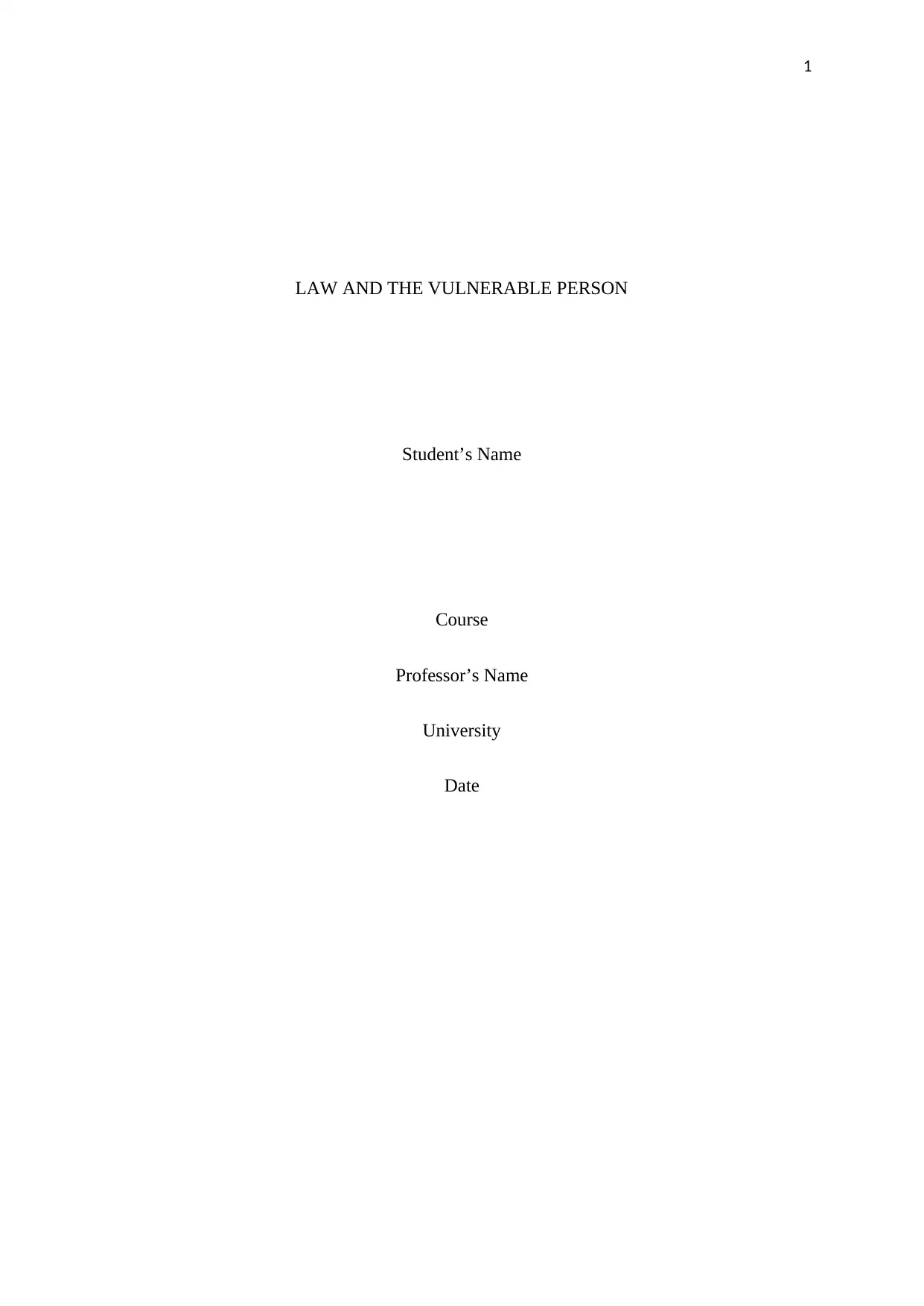
1
LAW AND THE VULNERABLE PERSON
Student’s Name
Course
Professor’s Name
University
Date
LAW AND THE VULNERABLE PERSON
Student’s Name
Course
Professor’s Name
University
Date
Paraphrase This Document
Need a fresh take? Get an instant paraphrase of this document with our AI Paraphraser
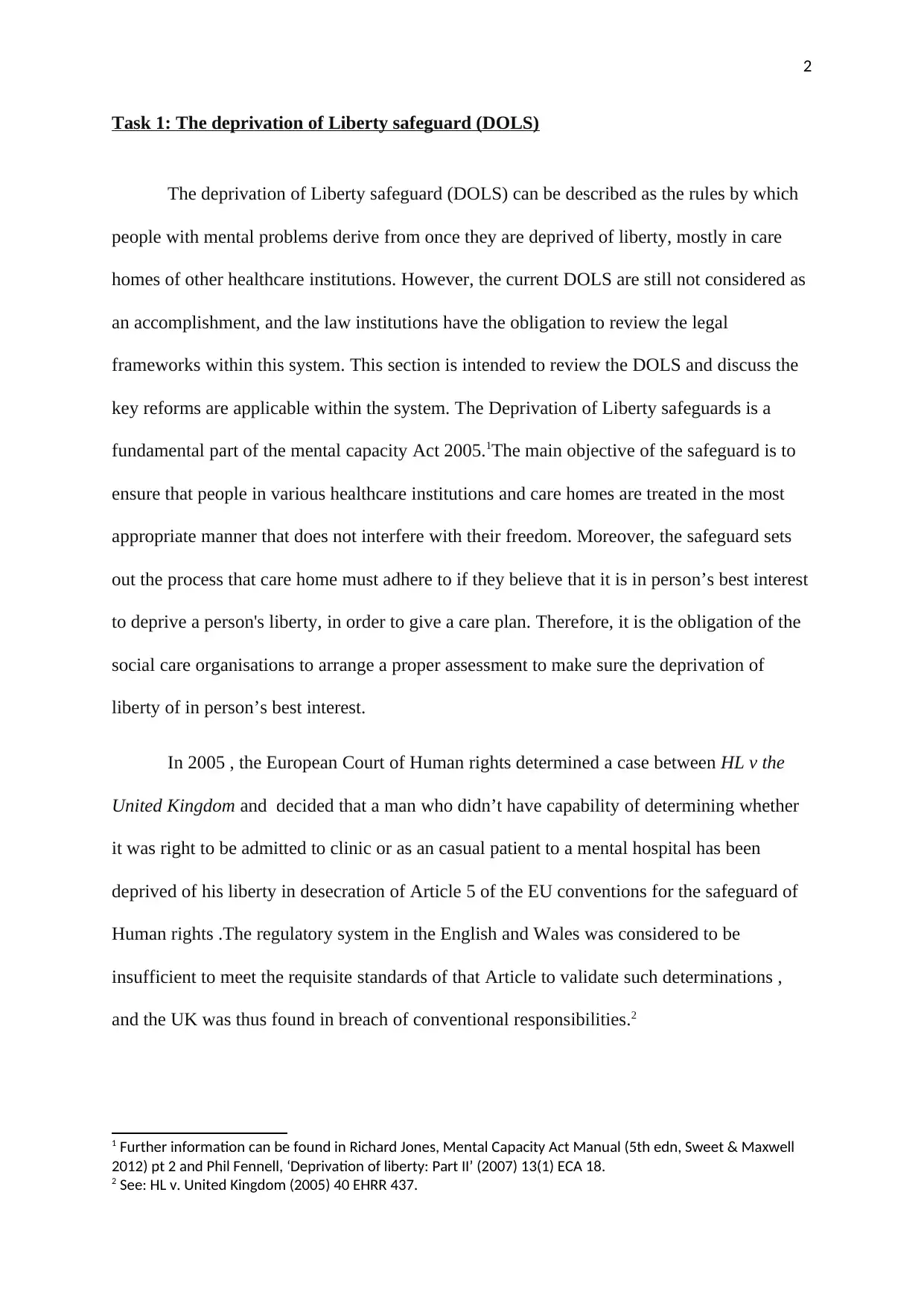
2
Task 1: The deprivation of Liberty safeguard (DOLS)
The deprivation of Liberty safeguard (DOLS) can be described as the rules by which
people with mental problems derive from once they are deprived of liberty, mostly in care
homes of other healthcare institutions. However, the current DOLS are still not considered as
an accomplishment, and the law institutions have the obligation to review the legal
frameworks within this system. This section is intended to review the DOLS and discuss the
key reforms are applicable within the system. The Deprivation of Liberty safeguards is a
fundamental part of the mental capacity Act 2005.1The main objective of the safeguard is to
ensure that people in various healthcare institutions and care homes are treated in the most
appropriate manner that does not interfere with their freedom. Moreover, the safeguard sets
out the process that care home must adhere to if they believe that it is in person’s best interest
to deprive a person's liberty, in order to give a care plan. Therefore, it is the obligation of the
social care organisations to arrange a proper assessment to make sure the deprivation of
liberty of in person’s best interest.
In 2005 , the European Court of Human rights determined a case between HL v the
United Kingdom and decided that a man who didn’t have capability of determining whether
it was right to be admitted to clinic or as an casual patient to a mental hospital has been
deprived of his liberty in desecration of Article 5 of the EU conventions for the safeguard of
Human rights .The regulatory system in the English and Wales was considered to be
insufficient to meet the requisite standards of that Article to validate such determinations ,
and the UK was thus found in breach of conventional responsibilities.2
1 Further information can be found in Richard Jones, Mental Capacity Act Manual (5th edn, Sweet & Maxwell
2012) pt 2 and Phil Fennell, ‘Deprivation of liberty: Part II’ (2007) 13(1) ECA 18.
2 See: HL v. United Kingdom (2005) 40 EHRR 437.
Task 1: The deprivation of Liberty safeguard (DOLS)
The deprivation of Liberty safeguard (DOLS) can be described as the rules by which
people with mental problems derive from once they are deprived of liberty, mostly in care
homes of other healthcare institutions. However, the current DOLS are still not considered as
an accomplishment, and the law institutions have the obligation to review the legal
frameworks within this system. This section is intended to review the DOLS and discuss the
key reforms are applicable within the system. The Deprivation of Liberty safeguards is a
fundamental part of the mental capacity Act 2005.1The main objective of the safeguard is to
ensure that people in various healthcare institutions and care homes are treated in the most
appropriate manner that does not interfere with their freedom. Moreover, the safeguard sets
out the process that care home must adhere to if they believe that it is in person’s best interest
to deprive a person's liberty, in order to give a care plan. Therefore, it is the obligation of the
social care organisations to arrange a proper assessment to make sure the deprivation of
liberty of in person’s best interest.
In 2005 , the European Court of Human rights determined a case between HL v the
United Kingdom and decided that a man who didn’t have capability of determining whether
it was right to be admitted to clinic or as an casual patient to a mental hospital has been
deprived of his liberty in desecration of Article 5 of the EU conventions for the safeguard of
Human rights .The regulatory system in the English and Wales was considered to be
insufficient to meet the requisite standards of that Article to validate such determinations ,
and the UK was thus found in breach of conventional responsibilities.2
1 Further information can be found in Richard Jones, Mental Capacity Act Manual (5th edn, Sweet & Maxwell
2012) pt 2 and Phil Fennell, ‘Deprivation of liberty: Part II’ (2007) 13(1) ECA 18.
2 See: HL v. United Kingdom (2005) 40 EHRR 437.
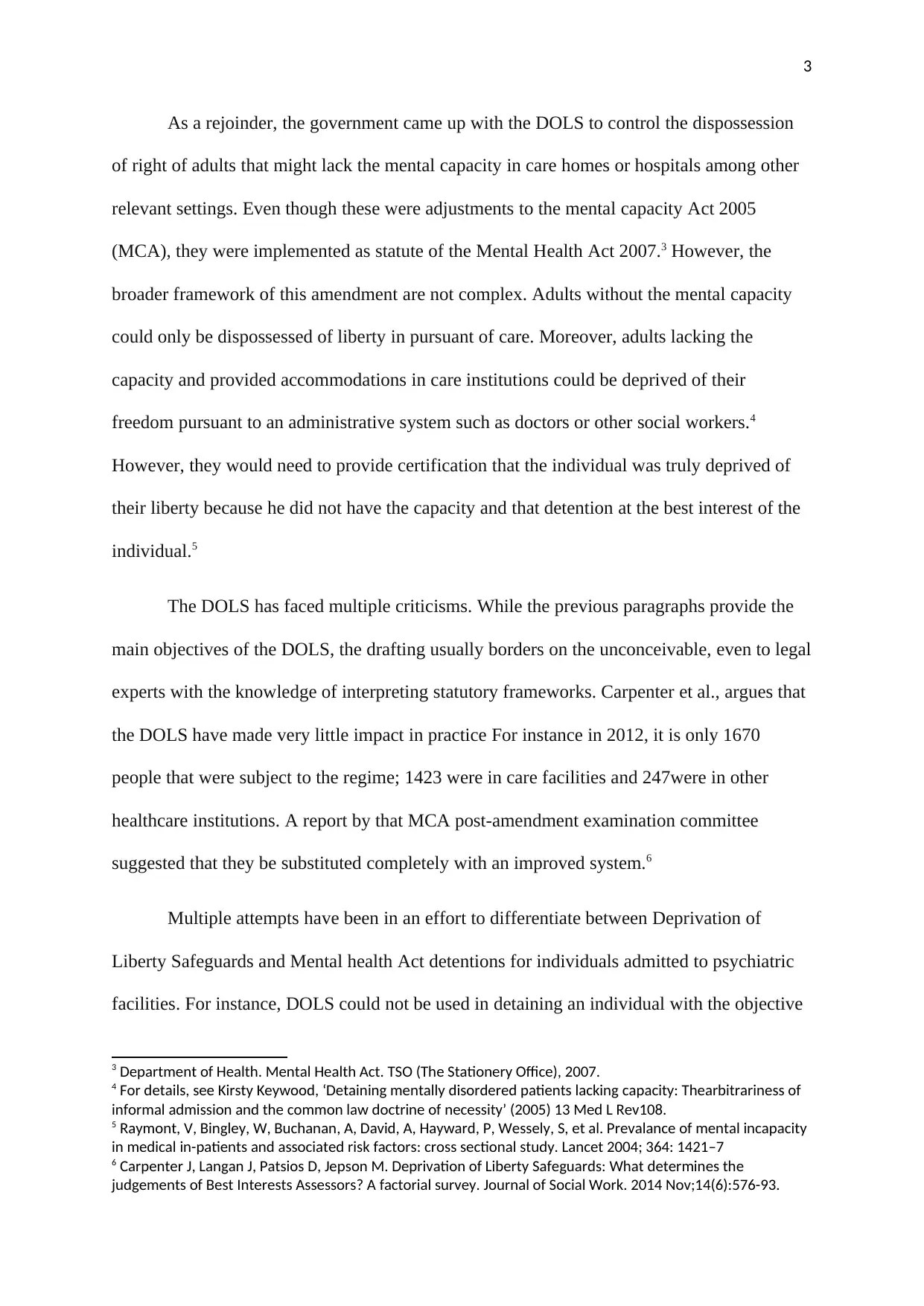
3
As a rejoinder, the government came up with the DOLS to control the dispossession
of right of adults that might lack the mental capacity in care homes or hospitals among other
relevant settings. Even though these were adjustments to the mental capacity Act 2005
(MCA), they were implemented as statute of the Mental Health Act 2007.3 However, the
broader framework of this amendment are not complex. Adults without the mental capacity
could only be dispossessed of liberty in pursuant of care. Moreover, adults lacking the
capacity and provided accommodations in care institutions could be deprived of their
freedom pursuant to an administrative system such as doctors or other social workers.4
However, they would need to provide certification that the individual was truly deprived of
their liberty because he did not have the capacity and that detention at the best interest of the
individual.5
The DOLS has faced multiple criticisms. While the previous paragraphs provide the
main objectives of the DOLS, the drafting usually borders on the unconceivable, even to legal
experts with the knowledge of interpreting statutory frameworks. Carpenter et al., argues that
the DOLS have made very little impact in practice For instance in 2012, it is only 1670
people that were subject to the regime; 1423 were in care facilities and 247were in other
healthcare institutions. A report by that MCA post-amendment examination committee
suggested that they be substituted completely with an improved system.6
Multiple attempts have been in an effort to differentiate between Deprivation of
Liberty Safeguards and Mental health Act detentions for individuals admitted to psychiatric
facilities. For instance, DOLS could not be used in detaining an individual with the objective
3 Department of Health. Mental Health Act. TSO (The Stationery Office), 2007.
4 For details, see Kirsty Keywood, ‘Detaining mentally disordered patients lacking capacity: Thearbitrariness of
informal admission and the common law doctrine of necessity’ (2005) 13 Med L Rev108.
5 Raymont, V, Bingley, W, Buchanan, A, David, A, Hayward, P, Wessely, S, et al. Prevalance of mental incapacity
in medical in-patients and associated risk factors: cross sectional study. Lancet 2004; 364: 1421–7
6 Carpenter J, Langan J, Patsios D, Jepson M. Deprivation of Liberty Safeguards: What determines the
judgements of Best Interests Assessors? A factorial survey. Journal of Social Work. 2014 Nov;14(6):576-93.
As a rejoinder, the government came up with the DOLS to control the dispossession
of right of adults that might lack the mental capacity in care homes or hospitals among other
relevant settings. Even though these were adjustments to the mental capacity Act 2005
(MCA), they were implemented as statute of the Mental Health Act 2007.3 However, the
broader framework of this amendment are not complex. Adults without the mental capacity
could only be dispossessed of liberty in pursuant of care. Moreover, adults lacking the
capacity and provided accommodations in care institutions could be deprived of their
freedom pursuant to an administrative system such as doctors or other social workers.4
However, they would need to provide certification that the individual was truly deprived of
their liberty because he did not have the capacity and that detention at the best interest of the
individual.5
The DOLS has faced multiple criticisms. While the previous paragraphs provide the
main objectives of the DOLS, the drafting usually borders on the unconceivable, even to legal
experts with the knowledge of interpreting statutory frameworks. Carpenter et al., argues that
the DOLS have made very little impact in practice For instance in 2012, it is only 1670
people that were subject to the regime; 1423 were in care facilities and 247were in other
healthcare institutions. A report by that MCA post-amendment examination committee
suggested that they be substituted completely with an improved system.6
Multiple attempts have been in an effort to differentiate between Deprivation of
Liberty Safeguards and Mental health Act detentions for individuals admitted to psychiatric
facilities. For instance, DOLS could not be used in detaining an individual with the objective
3 Department of Health. Mental Health Act. TSO (The Stationery Office), 2007.
4 For details, see Kirsty Keywood, ‘Detaining mentally disordered patients lacking capacity: Thearbitrariness of
informal admission and the common law doctrine of necessity’ (2005) 13 Med L Rev108.
5 Raymont, V, Bingley, W, Buchanan, A, David, A, Hayward, P, Wessely, S, et al. Prevalance of mental incapacity
in medical in-patients and associated risk factors: cross sectional study. Lancet 2004; 364: 1421–7
6 Carpenter J, Langan J, Patsios D, Jepson M. Deprivation of Liberty Safeguards: What determines the
judgements of Best Interests Assessors? A factorial survey. Journal of Social Work. 2014 Nov;14(6):576-93.
⊘ This is a preview!⊘
Do you want full access?
Subscribe today to unlock all pages.

Trusted by 1+ million students worldwide
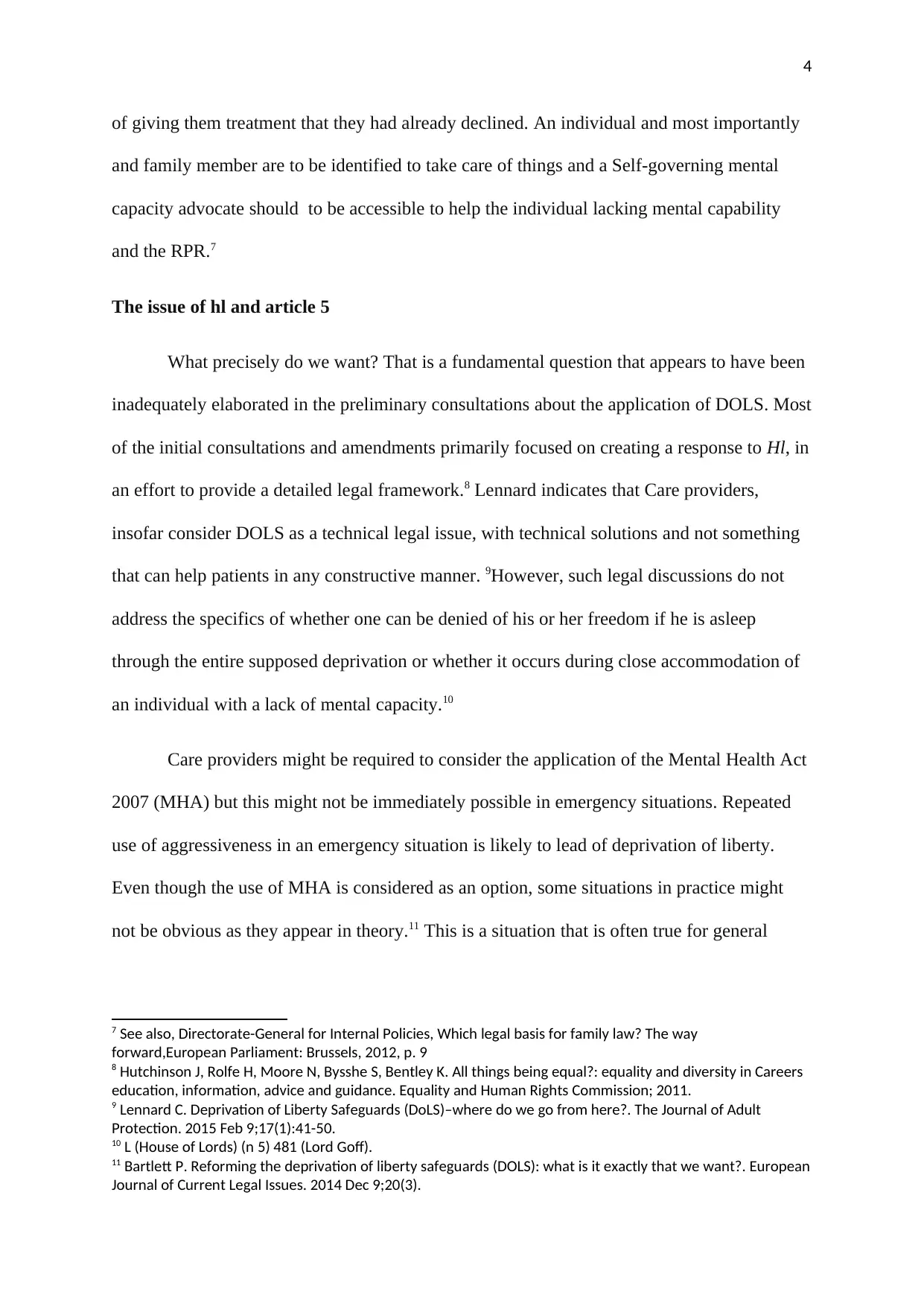
4
of giving them treatment that they had already declined. An individual and most importantly
and family member are to be identified to take care of things and a Self-governing mental
capacity advocate should to be accessible to help the individual lacking mental capability
and the RPR.7
The issue of hl and article 5
What precisely do we want? That is a fundamental question that appears to have been
inadequately elaborated in the preliminary consultations about the application of DOLS. Most
of the initial consultations and amendments primarily focused on creating a response to Hl, in
an effort to provide a detailed legal framework.8 Lennard indicates that Care providers,
insofar consider DOLS as a technical legal issue, with technical solutions and not something
that can help patients in any constructive manner. 9However, such legal discussions do not
address the specifics of whether one can be denied of his or her freedom if he is asleep
through the entire supposed deprivation or whether it occurs during close accommodation of
an individual with a lack of mental capacity.10
Care providers might be required to consider the application of the Mental Health Act
2007 (MHA) but this might not be immediately possible in emergency situations. Repeated
use of aggressiveness in an emergency situation is likely to lead of deprivation of liberty.
Even though the use of MHA is considered as an option, some situations in practice might
not be obvious as they appear in theory.11 This is a situation that is often true for general
7 See also, Directorate-General for Internal Policies, Which legal basis for family law? The way
forward,European Parliament: Brussels, 2012, p. 9
8 Hutchinson J, Rolfe H, Moore N, Bysshe S, Bentley K. All things being equal?: equality and diversity in Careers
education, information, advice and guidance. Equality and Human Rights Commission; 2011.
9 Lennard C. Deprivation of Liberty Safeguards (DoLS)–where do we go from here?. The Journal of Adult
Protection. 2015 Feb 9;17(1):41-50.
10 L (House of Lords) (n 5) 481 (Lord Goff).
11 Bartlett P. Reforming the deprivation of liberty safeguards (DOLS): what is it exactly that we want?. European
Journal of Current Legal Issues. 2014 Dec 9;20(3).
of giving them treatment that they had already declined. An individual and most importantly
and family member are to be identified to take care of things and a Self-governing mental
capacity advocate should to be accessible to help the individual lacking mental capability
and the RPR.7
The issue of hl and article 5
What precisely do we want? That is a fundamental question that appears to have been
inadequately elaborated in the preliminary consultations about the application of DOLS. Most
of the initial consultations and amendments primarily focused on creating a response to Hl, in
an effort to provide a detailed legal framework.8 Lennard indicates that Care providers,
insofar consider DOLS as a technical legal issue, with technical solutions and not something
that can help patients in any constructive manner. 9However, such legal discussions do not
address the specifics of whether one can be denied of his or her freedom if he is asleep
through the entire supposed deprivation or whether it occurs during close accommodation of
an individual with a lack of mental capacity.10
Care providers might be required to consider the application of the Mental Health Act
2007 (MHA) but this might not be immediately possible in emergency situations. Repeated
use of aggressiveness in an emergency situation is likely to lead of deprivation of liberty.
Even though the use of MHA is considered as an option, some situations in practice might
not be obvious as they appear in theory.11 This is a situation that is often true for general
7 See also, Directorate-General for Internal Policies, Which legal basis for family law? The way
forward,European Parliament: Brussels, 2012, p. 9
8 Hutchinson J, Rolfe H, Moore N, Bysshe S, Bentley K. All things being equal?: equality and diversity in Careers
education, information, advice and guidance. Equality and Human Rights Commission; 2011.
9 Lennard C. Deprivation of Liberty Safeguards (DoLS)–where do we go from here?. The Journal of Adult
Protection. 2015 Feb 9;17(1):41-50.
10 L (House of Lords) (n 5) 481 (Lord Goff).
11 Bartlett P. Reforming the deprivation of liberty safeguards (DOLS): what is it exactly that we want?. European
Journal of Current Legal Issues. 2014 Dec 9;20(3).
Paraphrase This Document
Need a fresh take? Get an instant paraphrase of this document with our AI Paraphraser
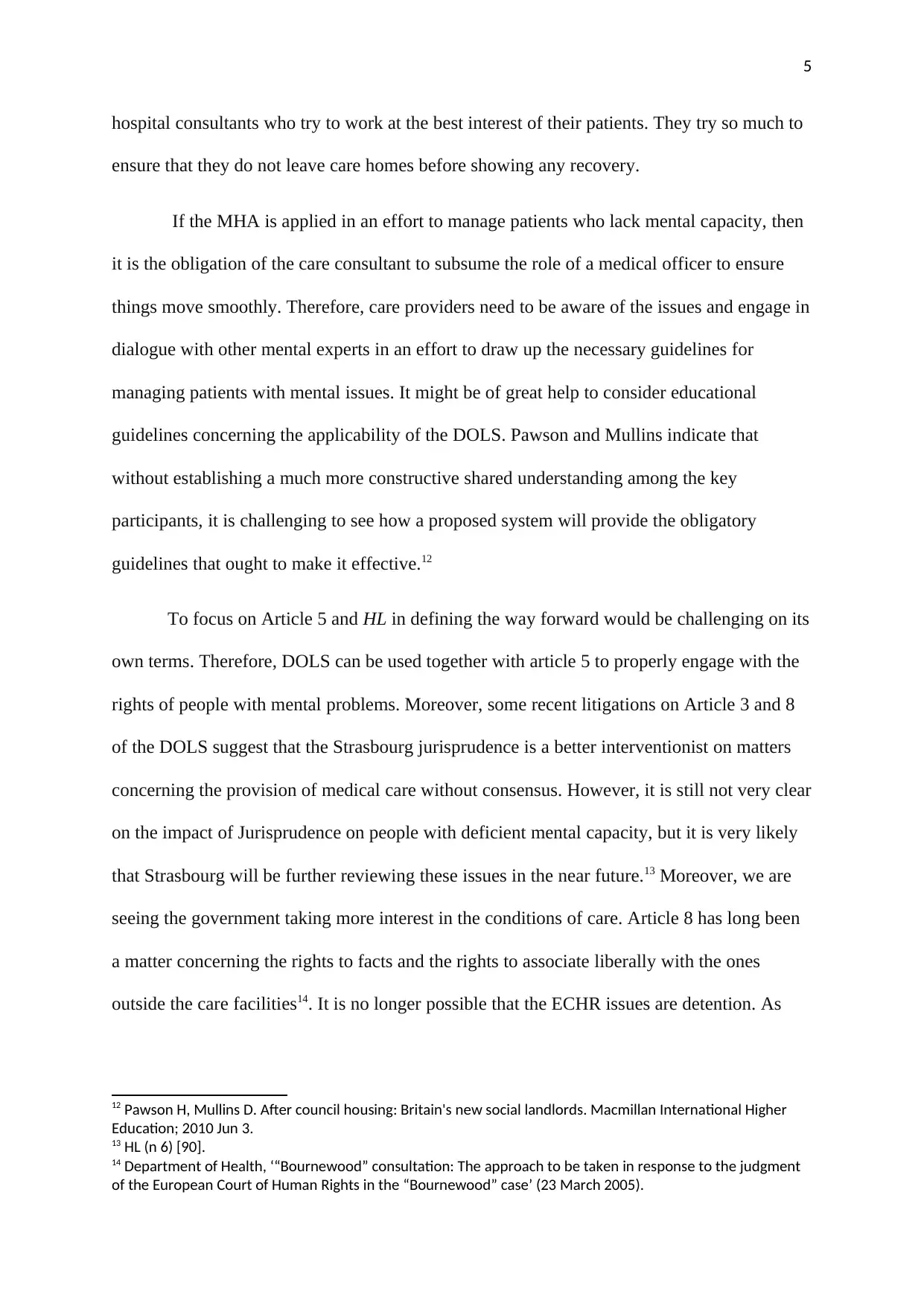
5
hospital consultants who try to work at the best interest of their patients. They try so much to
ensure that they do not leave care homes before showing any recovery.
If the MHA is applied in an effort to manage patients who lack mental capacity, then
it is the obligation of the care consultant to subsume the role of a medical officer to ensure
things move smoothly. Therefore, care providers need to be aware of the issues and engage in
dialogue with other mental experts in an effort to draw up the necessary guidelines for
managing patients with mental issues. It might be of great help to consider educational
guidelines concerning the applicability of the DOLS. Pawson and Mullins indicate that
without establishing a much more constructive shared understanding among the key
participants, it is challenging to see how a proposed system will provide the obligatory
guidelines that ought to make it effective.12
To focus on Article 5 and HL in defining the way forward would be challenging on its
own terms. Therefore, DOLS can be used together with article 5 to properly engage with the
rights of people with mental problems. Moreover, some recent litigations on Article 3 and 8
of the DOLS suggest that the Strasbourg jurisprudence is a better interventionist on matters
concerning the provision of medical care without consensus. However, it is still not very clear
on the impact of Jurisprudence on people with deficient mental capacity, but it is very likely
that Strasbourg will be further reviewing these issues in the near future.13 Moreover, we are
seeing the government taking more interest in the conditions of care. Article 8 has long been
a matter concerning the rights to facts and the rights to associate liberally with the ones
outside the care facilities14. It is no longer possible that the ECHR issues are detention. As
12 Pawson H, Mullins D. After council housing: Britain's new social landlords. Macmillan International Higher
Education; 2010 Jun 3.
13 HL (n 6) [90].
14 Department of Health, ‘“Bournewood” consultation: The approach to be taken in response to the judgment
of the European Court of Human Rights in the “Bournewood” case’ (23 March 2005).
hospital consultants who try to work at the best interest of their patients. They try so much to
ensure that they do not leave care homes before showing any recovery.
If the MHA is applied in an effort to manage patients who lack mental capacity, then
it is the obligation of the care consultant to subsume the role of a medical officer to ensure
things move smoothly. Therefore, care providers need to be aware of the issues and engage in
dialogue with other mental experts in an effort to draw up the necessary guidelines for
managing patients with mental issues. It might be of great help to consider educational
guidelines concerning the applicability of the DOLS. Pawson and Mullins indicate that
without establishing a much more constructive shared understanding among the key
participants, it is challenging to see how a proposed system will provide the obligatory
guidelines that ought to make it effective.12
To focus on Article 5 and HL in defining the way forward would be challenging on its
own terms. Therefore, DOLS can be used together with article 5 to properly engage with the
rights of people with mental problems. Moreover, some recent litigations on Article 3 and 8
of the DOLS suggest that the Strasbourg jurisprudence is a better interventionist on matters
concerning the provision of medical care without consensus. However, it is still not very clear
on the impact of Jurisprudence on people with deficient mental capacity, but it is very likely
that Strasbourg will be further reviewing these issues in the near future.13 Moreover, we are
seeing the government taking more interest in the conditions of care. Article 8 has long been
a matter concerning the rights to facts and the rights to associate liberally with the ones
outside the care facilities14. It is no longer possible that the ECHR issues are detention. As
12 Pawson H, Mullins D. After council housing: Britain's new social landlords. Macmillan International Higher
Education; 2010 Jun 3.
13 HL (n 6) [90].
14 Department of Health, ‘“Bournewood” consultation: The approach to be taken in response to the judgment
of the European Court of Human Rights in the “Bournewood” case’ (23 March 2005).
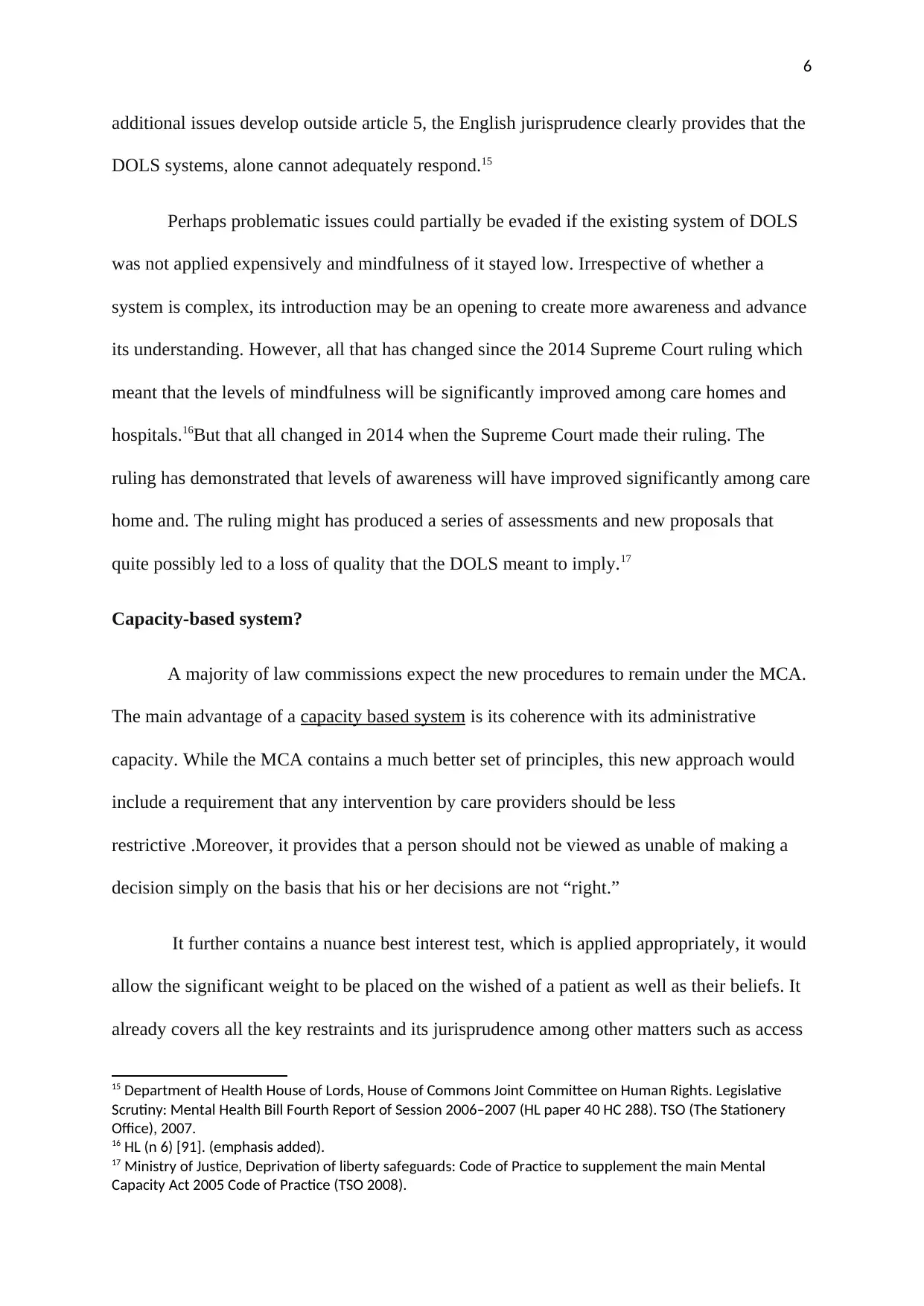
6
additional issues develop outside article 5, the English jurisprudence clearly provides that the
DOLS systems, alone cannot adequately respond.15
Perhaps problematic issues could partially be evaded if the existing system of DOLS
was not applied expensively and mindfulness of it stayed low. Irrespective of whether a
system is complex, its introduction may be an opening to create more awareness and advance
its understanding. However, all that has changed since the 2014 Supreme Court ruling which
meant that the levels of mindfulness will be significantly improved among care homes and
hospitals.16But that all changed in 2014 when the Supreme Court made their ruling. The
ruling has demonstrated that levels of awareness will have improved significantly among care
home and. The ruling might has produced a series of assessments and new proposals that
quite possibly led to a loss of quality that the DOLS meant to imply.17
Capacity-based system?
A majority of law commissions expect the new procedures to remain under the MCA.
The main advantage of a capacity based system is its coherence with its administrative
capacity. While the MCA contains a much better set of principles, this new approach would
include a requirement that any intervention by care providers should be less
restrictive .Moreover, it provides that a person should not be viewed as unable of making a
decision simply on the basis that his or her decisions are not “right.”
It further contains a nuance best interest test, which is applied appropriately, it would
allow the significant weight to be placed on the wished of a patient as well as their beliefs. It
already covers all the key restraints and its jurisprudence among other matters such as access
15 Department of Health House of Lords, House of Commons Joint Committee on Human Rights. Legislative
Scrutiny: Mental Health Bill Fourth Report of Session 2006–2007 (HL paper 40 HC 288). TSO (The Stationery
Office), 2007.
16 HL (n 6) [91]. (emphasis added).
17 Ministry of Justice, Deprivation of liberty safeguards: Code of Practice to supplement the main Mental
Capacity Act 2005 Code of Practice (TSO 2008).
additional issues develop outside article 5, the English jurisprudence clearly provides that the
DOLS systems, alone cannot adequately respond.15
Perhaps problematic issues could partially be evaded if the existing system of DOLS
was not applied expensively and mindfulness of it stayed low. Irrespective of whether a
system is complex, its introduction may be an opening to create more awareness and advance
its understanding. However, all that has changed since the 2014 Supreme Court ruling which
meant that the levels of mindfulness will be significantly improved among care homes and
hospitals.16But that all changed in 2014 when the Supreme Court made their ruling. The
ruling has demonstrated that levels of awareness will have improved significantly among care
home and. The ruling might has produced a series of assessments and new proposals that
quite possibly led to a loss of quality that the DOLS meant to imply.17
Capacity-based system?
A majority of law commissions expect the new procedures to remain under the MCA.
The main advantage of a capacity based system is its coherence with its administrative
capacity. While the MCA contains a much better set of principles, this new approach would
include a requirement that any intervention by care providers should be less
restrictive .Moreover, it provides that a person should not be viewed as unable of making a
decision simply on the basis that his or her decisions are not “right.”
It further contains a nuance best interest test, which is applied appropriately, it would
allow the significant weight to be placed on the wished of a patient as well as their beliefs. It
already covers all the key restraints and its jurisprudence among other matters such as access
15 Department of Health House of Lords, House of Commons Joint Committee on Human Rights. Legislative
Scrutiny: Mental Health Bill Fourth Report of Session 2006–2007 (HL paper 40 HC 288). TSO (The Stationery
Office), 2007.
16 HL (n 6) [91]. (emphasis added).
17 Ministry of Justice, Deprivation of liberty safeguards: Code of Practice to supplement the main Mental
Capacity Act 2005 Code of Practice (TSO 2008).
⊘ This is a preview!⊘
Do you want full access?
Subscribe today to unlock all pages.

Trusted by 1+ million students worldwide
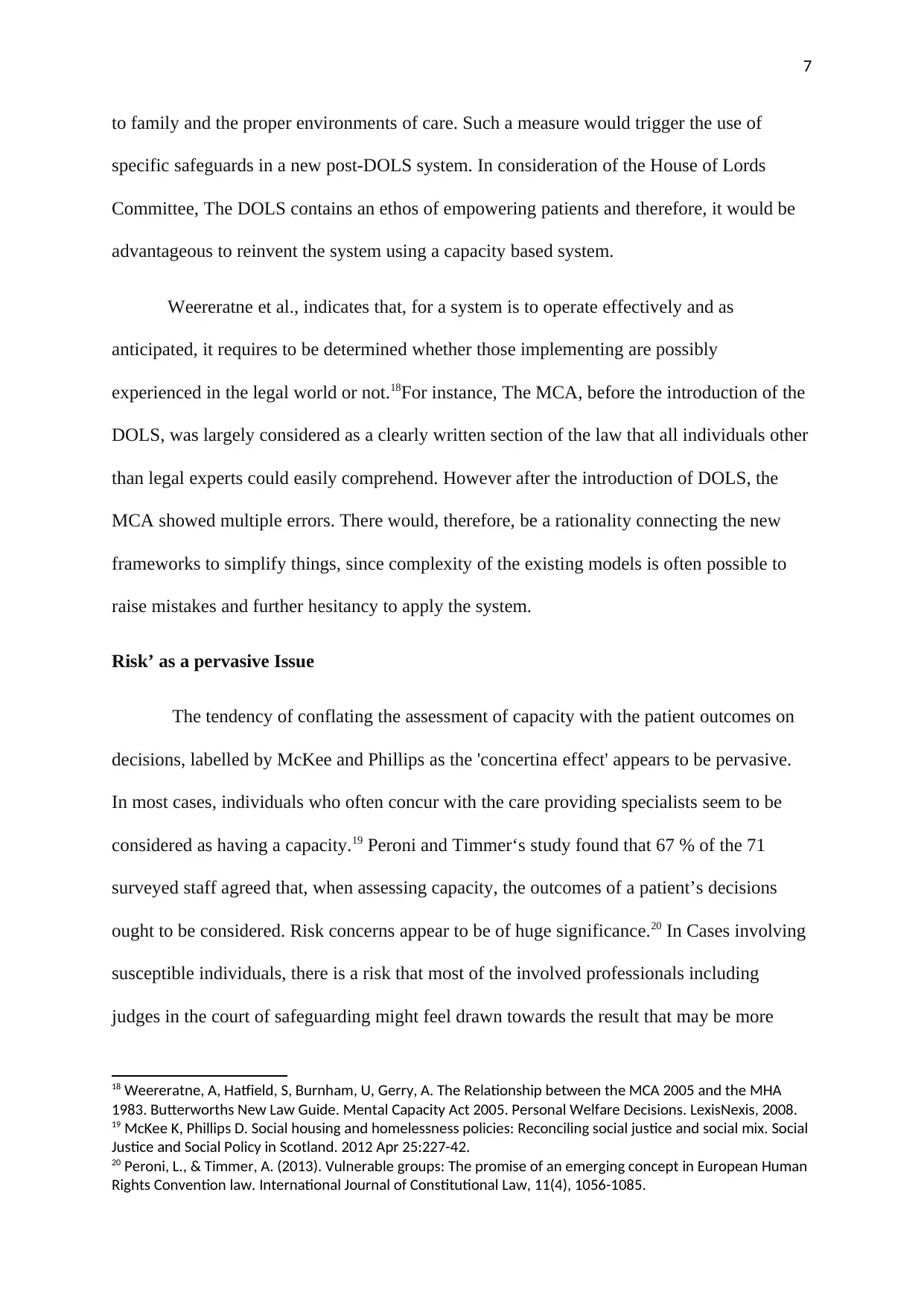
7
to family and the proper environments of care. Such a measure would trigger the use of
specific safeguards in a new post-DOLS system. In consideration of the House of Lords
Committee, The DOLS contains an ethos of empowering patients and therefore, it would be
advantageous to reinvent the system using a capacity based system.
Weereratne et al., indicates that, for a system is to operate effectively and as
anticipated, it requires to be determined whether those implementing are possibly
experienced in the legal world or not.18For instance, The MCA, before the introduction of the
DOLS, was largely considered as a clearly written section of the law that all individuals other
than legal experts could easily comprehend. However after the introduction of DOLS, the
MCA showed multiple errors. There would, therefore, be a rationality connecting the new
frameworks to simplify things, since complexity of the existing models is often possible to
raise mistakes and further hesitancy to apply the system.
Risk’ as a pervasive Issue
The tendency of conflating the assessment of capacity with the patient outcomes on
decisions, labelled by McKee and Phillips as the 'concertina effect' appears to be pervasive.
In most cases, individuals who often concur with the care providing specialists seem to be
considered as having a capacity.19 Peroni and Timmer‘s study found that 67 % of the 71
surveyed staff agreed that, when assessing capacity, the outcomes of a patient’s decisions
ought to be considered. Risk concerns appear to be of huge significance.20 In Cases involving
susceptible individuals, there is a risk that most of the involved professionals including
judges in the court of safeguarding might feel drawn towards the result that may be more
18 Weereratne, A, Hatfield, S, Burnham, U, Gerry, A. The Relationship between the MCA 2005 and the MHA
1983. Butterworths New Law Guide. Mental Capacity Act 2005. Personal Welfare Decisions. LexisNexis, 2008.
19 McKee K, Phillips D. Social housing and homelessness policies: Reconciling social justice and social mix. Social
Justice and Social Policy in Scotland. 2012 Apr 25:227-42.
20 Peroni, L., & Timmer, A. (2013). Vulnerable groups: The promise of an emerging concept in European Human
Rights Convention law. International Journal of Constitutional Law, 11(4), 1056-1085.
to family and the proper environments of care. Such a measure would trigger the use of
specific safeguards in a new post-DOLS system. In consideration of the House of Lords
Committee, The DOLS contains an ethos of empowering patients and therefore, it would be
advantageous to reinvent the system using a capacity based system.
Weereratne et al., indicates that, for a system is to operate effectively and as
anticipated, it requires to be determined whether those implementing are possibly
experienced in the legal world or not.18For instance, The MCA, before the introduction of the
DOLS, was largely considered as a clearly written section of the law that all individuals other
than legal experts could easily comprehend. However after the introduction of DOLS, the
MCA showed multiple errors. There would, therefore, be a rationality connecting the new
frameworks to simplify things, since complexity of the existing models is often possible to
raise mistakes and further hesitancy to apply the system.
Risk’ as a pervasive Issue
The tendency of conflating the assessment of capacity with the patient outcomes on
decisions, labelled by McKee and Phillips as the 'concertina effect' appears to be pervasive.
In most cases, individuals who often concur with the care providing specialists seem to be
considered as having a capacity.19 Peroni and Timmer‘s study found that 67 % of the 71
surveyed staff agreed that, when assessing capacity, the outcomes of a patient’s decisions
ought to be considered. Risk concerns appear to be of huge significance.20 In Cases involving
susceptible individuals, there is a risk that most of the involved professionals including
judges in the court of safeguarding might feel drawn towards the result that may be more
18 Weereratne, A, Hatfield, S, Burnham, U, Gerry, A. The Relationship between the MCA 2005 and the MHA
1983. Butterworths New Law Guide. Mental Capacity Act 2005. Personal Welfare Decisions. LexisNexis, 2008.
19 McKee K, Phillips D. Social housing and homelessness policies: Reconciling social justice and social mix. Social
Justice and Social Policy in Scotland. 2012 Apr 25:227-42.
20 Peroni, L., & Timmer, A. (2013). Vulnerable groups: The promise of an emerging concept in European Human
Rights Convention law. International Journal of Constitutional Law, 11(4), 1056-1085.
Paraphrase This Document
Need a fresh take? Get an instant paraphrase of this document with our AI Paraphraser
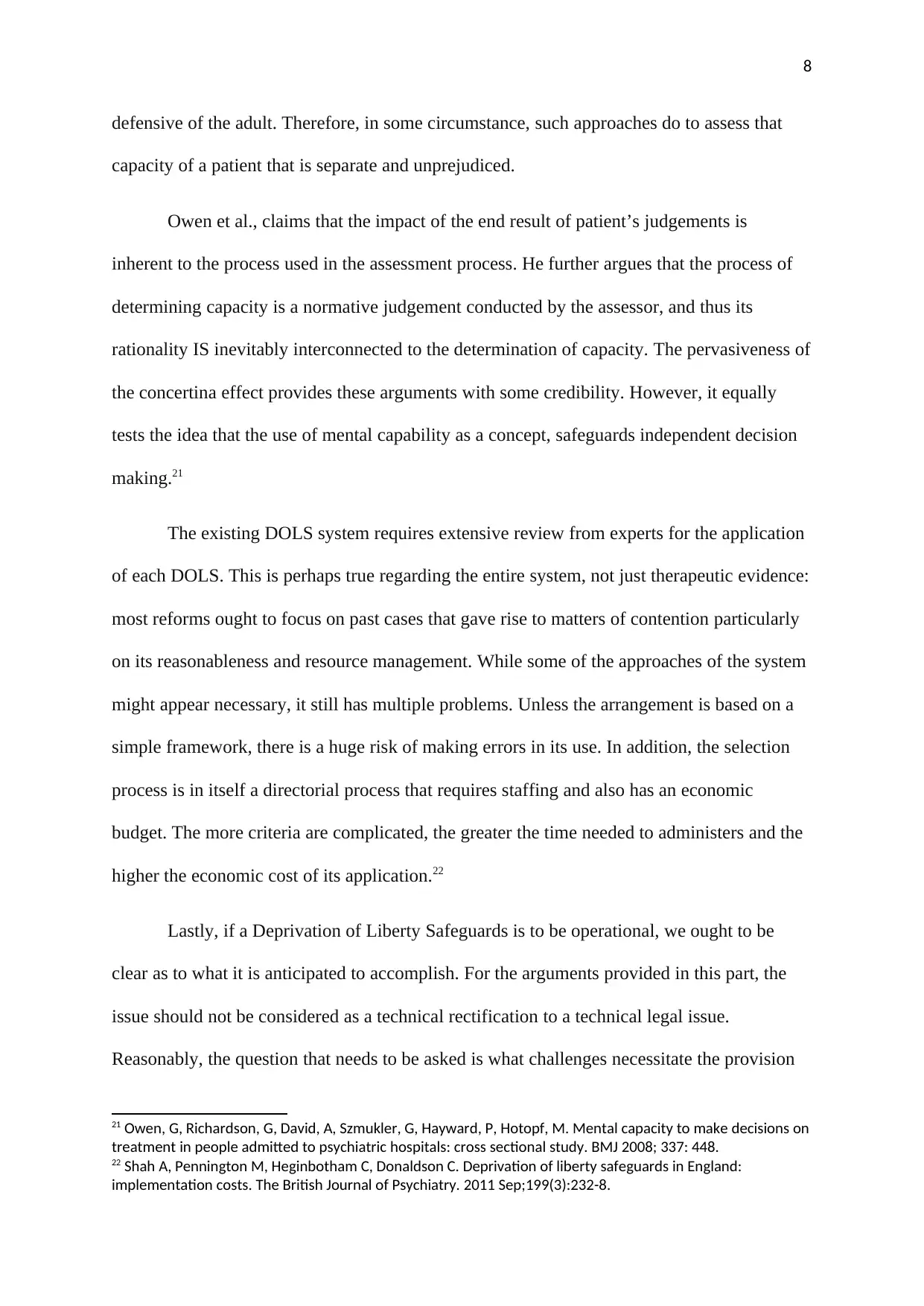
8
defensive of the adult. Therefore, in some circumstance, such approaches do to assess that
capacity of a patient that is separate and unprejudiced.
Owen et al., claims that the impact of the end result of patient’s judgements is
inherent to the process used in the assessment process. He further argues that the process of
determining capacity is a normative judgement conducted by the assessor, and thus its
rationality IS inevitably interconnected to the determination of capacity. The pervasiveness of
the concertina effect provides these arguments with some credibility. However, it equally
tests the idea that the use of mental capability as a concept, safeguards independent decision
making.21
The existing DOLS system requires extensive review from experts for the application
of each DOLS. This is perhaps true regarding the entire system, not just therapeutic evidence:
most reforms ought to focus on past cases that gave rise to matters of contention particularly
on its reasonableness and resource management. While some of the approaches of the system
might appear necessary, it still has multiple problems. Unless the arrangement is based on a
simple framework, there is a huge risk of making errors in its use. In addition, the selection
process is in itself a directorial process that requires staffing and also has an economic
budget. The more criteria are complicated, the greater the time needed to administers and the
higher the economic cost of its application.22
Lastly, if a Deprivation of Liberty Safeguards is to be operational, we ought to be
clear as to what it is anticipated to accomplish. For the arguments provided in this part, the
issue should not be considered as a technical rectification to a technical legal issue.
Reasonably, the question that needs to be asked is what challenges necessitate the provision
21 Owen, G, Richardson, G, David, A, Szmukler, G, Hayward, P, Hotopf, M. Mental capacity to make decisions on
treatment in people admitted to psychiatric hospitals: cross sectional study. BMJ 2008; 337: 448.
22 Shah A, Pennington M, Heginbotham C, Donaldson C. Deprivation of liberty safeguards in England:
implementation costs. The British Journal of Psychiatry. 2011 Sep;199(3):232-8.
defensive of the adult. Therefore, in some circumstance, such approaches do to assess that
capacity of a patient that is separate and unprejudiced.
Owen et al., claims that the impact of the end result of patient’s judgements is
inherent to the process used in the assessment process. He further argues that the process of
determining capacity is a normative judgement conducted by the assessor, and thus its
rationality IS inevitably interconnected to the determination of capacity. The pervasiveness of
the concertina effect provides these arguments with some credibility. However, it equally
tests the idea that the use of mental capability as a concept, safeguards independent decision
making.21
The existing DOLS system requires extensive review from experts for the application
of each DOLS. This is perhaps true regarding the entire system, not just therapeutic evidence:
most reforms ought to focus on past cases that gave rise to matters of contention particularly
on its reasonableness and resource management. While some of the approaches of the system
might appear necessary, it still has multiple problems. Unless the arrangement is based on a
simple framework, there is a huge risk of making errors in its use. In addition, the selection
process is in itself a directorial process that requires staffing and also has an economic
budget. The more criteria are complicated, the greater the time needed to administers and the
higher the economic cost of its application.22
Lastly, if a Deprivation of Liberty Safeguards is to be operational, we ought to be
clear as to what it is anticipated to accomplish. For the arguments provided in this part, the
issue should not be considered as a technical rectification to a technical legal issue.
Reasonably, the question that needs to be asked is what challenges necessitate the provision
21 Owen, G, Richardson, G, David, A, Szmukler, G, Hayward, P, Hotopf, M. Mental capacity to make decisions on
treatment in people admitted to psychiatric hospitals: cross sectional study. BMJ 2008; 337: 448.
22 Shah A, Pennington M, Heginbotham C, Donaldson C. Deprivation of liberty safeguards in England:
implementation costs. The British Journal of Psychiatry. 2011 Sep;199(3):232-8.
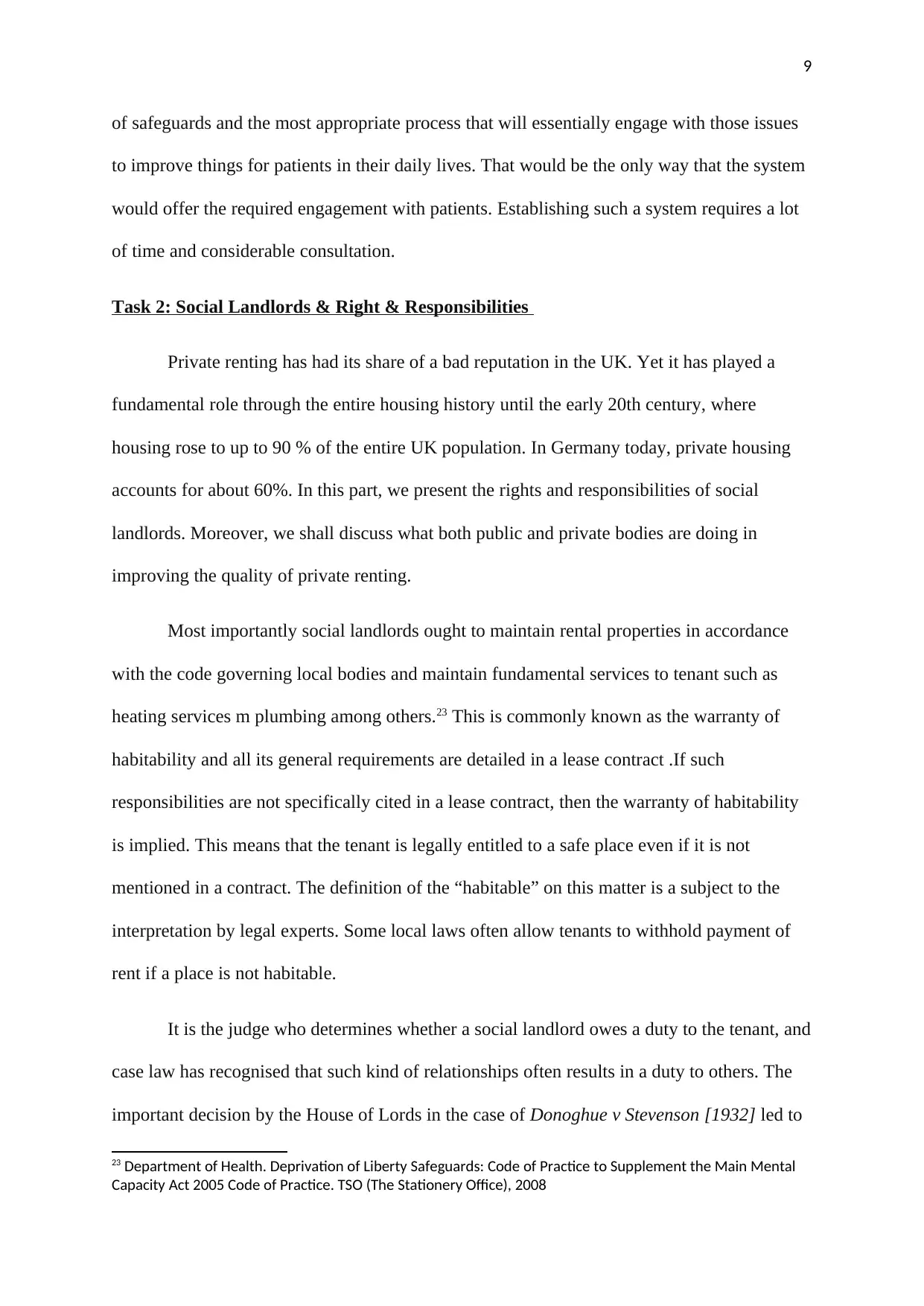
9
of safeguards and the most appropriate process that will essentially engage with those issues
to improve things for patients in their daily lives. That would be the only way that the system
would offer the required engagement with patients. Establishing such a system requires a lot
of time and considerable consultation.
Task 2: Social Landlords & Right & Responsibilities
Private renting has had its share of a bad reputation in the UK. Yet it has played a
fundamental role through the entire housing history until the early 20th century, where
housing rose to up to 90 % of the entire UK population. In Germany today, private housing
accounts for about 60%. In this part, we present the rights and responsibilities of social
landlords. Moreover, we shall discuss what both public and private bodies are doing in
improving the quality of private renting.
Most importantly social landlords ought to maintain rental properties in accordance
with the code governing local bodies and maintain fundamental services to tenant such as
heating services m plumbing among others.23 This is commonly known as the warranty of
habitability and all its general requirements are detailed in a lease contract .If such
responsibilities are not specifically cited in a lease contract, then the warranty of habitability
is implied. This means that the tenant is legally entitled to a safe place even if it is not
mentioned in a contract. The definition of the “habitable” on this matter is a subject to the
interpretation by legal experts. Some local laws often allow tenants to withhold payment of
rent if a place is not habitable.
It is the judge who determines whether a social landlord owes a duty to the tenant, and
case law has recognised that such kind of relationships often results in a duty to others. The
important decision by the House of Lords in the case of Donoghue v Stevenson [1932] led to
23 Department of Health. Deprivation of Liberty Safeguards: Code of Practice to Supplement the Main Mental
Capacity Act 2005 Code of Practice. TSO (The Stationery Office), 2008
of safeguards and the most appropriate process that will essentially engage with those issues
to improve things for patients in their daily lives. That would be the only way that the system
would offer the required engagement with patients. Establishing such a system requires a lot
of time and considerable consultation.
Task 2: Social Landlords & Right & Responsibilities
Private renting has had its share of a bad reputation in the UK. Yet it has played a
fundamental role through the entire housing history until the early 20th century, where
housing rose to up to 90 % of the entire UK population. In Germany today, private housing
accounts for about 60%. In this part, we present the rights and responsibilities of social
landlords. Moreover, we shall discuss what both public and private bodies are doing in
improving the quality of private renting.
Most importantly social landlords ought to maintain rental properties in accordance
with the code governing local bodies and maintain fundamental services to tenant such as
heating services m plumbing among others.23 This is commonly known as the warranty of
habitability and all its general requirements are detailed in a lease contract .If such
responsibilities are not specifically cited in a lease contract, then the warranty of habitability
is implied. This means that the tenant is legally entitled to a safe place even if it is not
mentioned in a contract. The definition of the “habitable” on this matter is a subject to the
interpretation by legal experts. Some local laws often allow tenants to withhold payment of
rent if a place is not habitable.
It is the judge who determines whether a social landlord owes a duty to the tenant, and
case law has recognised that such kind of relationships often results in a duty to others. The
important decision by the House of Lords in the case of Donoghue v Stevenson [1932] led to
23 Department of Health. Deprivation of Liberty Safeguards: Code of Practice to Supplement the Main Mental
Capacity Act 2005 Code of Practice. TSO (The Stationery Office), 2008
⊘ This is a preview!⊘
Do you want full access?
Subscribe today to unlock all pages.

Trusted by 1+ million students worldwide
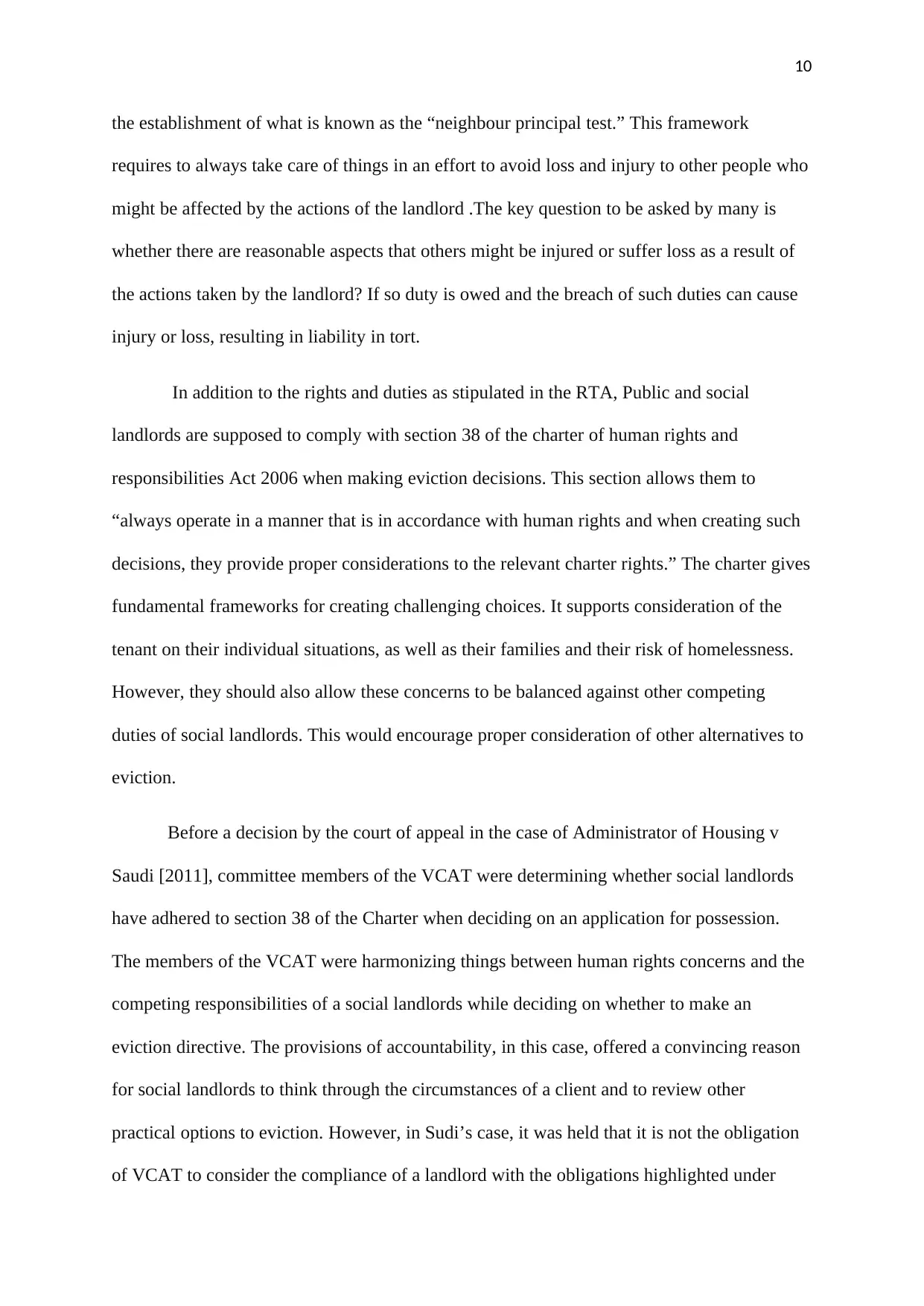
10
the establishment of what is known as the “neighbour principal test.” This framework
requires to always take care of things in an effort to avoid loss and injury to other people who
might be affected by the actions of the landlord .The key question to be asked by many is
whether there are reasonable aspects that others might be injured or suffer loss as a result of
the actions taken by the landlord? If so duty is owed and the breach of such duties can cause
injury or loss, resulting in liability in tort.
In addition to the rights and duties as stipulated in the RTA, Public and social
landlords are supposed to comply with section 38 of the charter of human rights and
responsibilities Act 2006 when making eviction decisions. This section allows them to
“always operate in a manner that is in accordance with human rights and when creating such
decisions, they provide proper considerations to the relevant charter rights.” The charter gives
fundamental frameworks for creating challenging choices. It supports consideration of the
tenant on their individual situations, as well as their families and their risk of homelessness.
However, they should also allow these concerns to be balanced against other competing
duties of social landlords. This would encourage proper consideration of other alternatives to
eviction.
Before a decision by the court of appeal in the case of Administrator of Housing v
Saudi [2011], committee members of the VCAT were determining whether social landlords
have adhered to section 38 of the Charter when deciding on an application for possession.
The members of the VCAT were harmonizing things between human rights concerns and the
competing responsibilities of a social landlords while deciding on whether to make an
eviction directive. The provisions of accountability, in this case, offered a convincing reason
for social landlords to think through the circumstances of a client and to review other
practical options to eviction. However, in Sudi’s case, it was held that it is not the obligation
of VCAT to consider the compliance of a landlord with the obligations highlighted under
the establishment of what is known as the “neighbour principal test.” This framework
requires to always take care of things in an effort to avoid loss and injury to other people who
might be affected by the actions of the landlord .The key question to be asked by many is
whether there are reasonable aspects that others might be injured or suffer loss as a result of
the actions taken by the landlord? If so duty is owed and the breach of such duties can cause
injury or loss, resulting in liability in tort.
In addition to the rights and duties as stipulated in the RTA, Public and social
landlords are supposed to comply with section 38 of the charter of human rights and
responsibilities Act 2006 when making eviction decisions. This section allows them to
“always operate in a manner that is in accordance with human rights and when creating such
decisions, they provide proper considerations to the relevant charter rights.” The charter gives
fundamental frameworks for creating challenging choices. It supports consideration of the
tenant on their individual situations, as well as their families and their risk of homelessness.
However, they should also allow these concerns to be balanced against other competing
duties of social landlords. This would encourage proper consideration of other alternatives to
eviction.
Before a decision by the court of appeal in the case of Administrator of Housing v
Saudi [2011], committee members of the VCAT were determining whether social landlords
have adhered to section 38 of the Charter when deciding on an application for possession.
The members of the VCAT were harmonizing things between human rights concerns and the
competing responsibilities of a social landlords while deciding on whether to make an
eviction directive. The provisions of accountability, in this case, offered a convincing reason
for social landlords to think through the circumstances of a client and to review other
practical options to eviction. However, in Sudi’s case, it was held that it is not the obligation
of VCAT to consider the compliance of a landlord with the obligations highlighted under
Paraphrase This Document
Need a fresh take? Get an instant paraphrase of this document with our AI Paraphraser
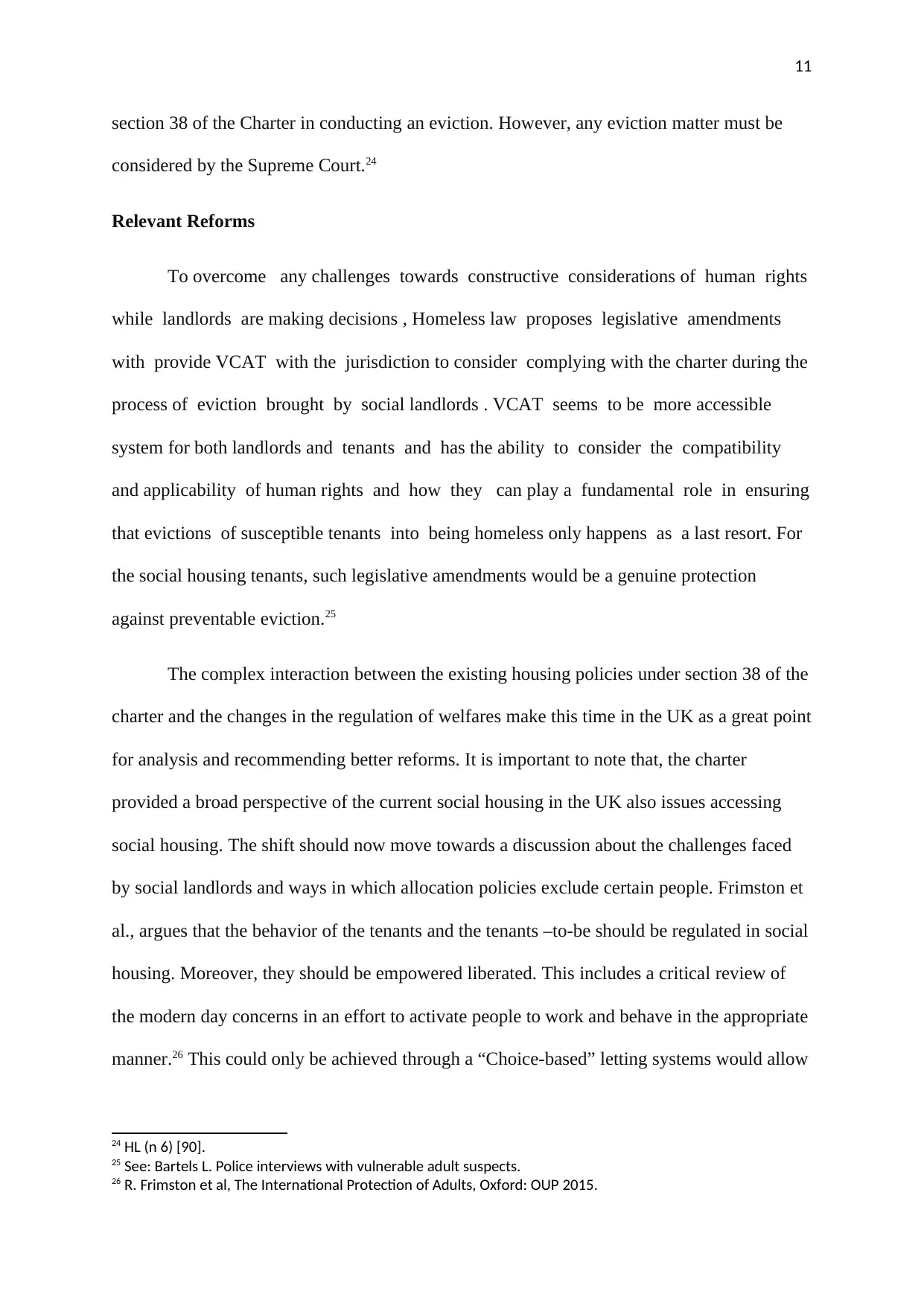
11
section 38 of the Charter in conducting an eviction. However, any eviction matter must be
considered by the Supreme Court.24
Relevant Reforms
To overcome any challenges towards constructive considerations of human rights
while landlords are making decisions , Homeless law proposes legislative amendments
with provide VCAT with the jurisdiction to consider complying with the charter during the
process of eviction brought by social landlords . VCAT seems to be more accessible
system for both landlords and tenants and has the ability to consider the compatibility
and applicability of human rights and how they can play a fundamental role in ensuring
that evictions of susceptible tenants into being homeless only happens as a last resort. For
the social housing tenants, such legislative amendments would be a genuine protection
against preventable eviction.25
The complex interaction between the existing housing policies under section 38 of the
charter and the changes in the regulation of welfares make this time in the UK as a great point
for analysis and recommending better reforms. It is important to note that, the charter
provided a broad perspective of the current social housing in the UK also issues accessing
social housing. The shift should now move towards a discussion about the challenges faced
by social landlords and ways in which allocation policies exclude certain people. Frimston et
al., argues that the behavior of the tenants and the tenants –to-be should be regulated in social
housing. Moreover, they should be empowered liberated. This includes a critical review of
the modern day concerns in an effort to activate people to work and behave in the appropriate
manner.26 This could only be achieved through a “Choice-based” letting systems would allow
24 HL (n 6) [90].
25 See: Bartels L. Police interviews with vulnerable adult suspects.
26 R. Frimston et al, The International Protection of Adults, Oxford: OUP 2015.
section 38 of the Charter in conducting an eviction. However, any eviction matter must be
considered by the Supreme Court.24
Relevant Reforms
To overcome any challenges towards constructive considerations of human rights
while landlords are making decisions , Homeless law proposes legislative amendments
with provide VCAT with the jurisdiction to consider complying with the charter during the
process of eviction brought by social landlords . VCAT seems to be more accessible
system for both landlords and tenants and has the ability to consider the compatibility
and applicability of human rights and how they can play a fundamental role in ensuring
that evictions of susceptible tenants into being homeless only happens as a last resort. For
the social housing tenants, such legislative amendments would be a genuine protection
against preventable eviction.25
The complex interaction between the existing housing policies under section 38 of the
charter and the changes in the regulation of welfares make this time in the UK as a great point
for analysis and recommending better reforms. It is important to note that, the charter
provided a broad perspective of the current social housing in the UK also issues accessing
social housing. The shift should now move towards a discussion about the challenges faced
by social landlords and ways in which allocation policies exclude certain people. Frimston et
al., argues that the behavior of the tenants and the tenants –to-be should be regulated in social
housing. Moreover, they should be empowered liberated. This includes a critical review of
the modern day concerns in an effort to activate people to work and behave in the appropriate
manner.26 This could only be achieved through a “Choice-based” letting systems would allow
24 HL (n 6) [90].
25 See: Bartels L. Police interviews with vulnerable adult suspects.
26 R. Frimston et al, The International Protection of Adults, Oxford: OUP 2015.
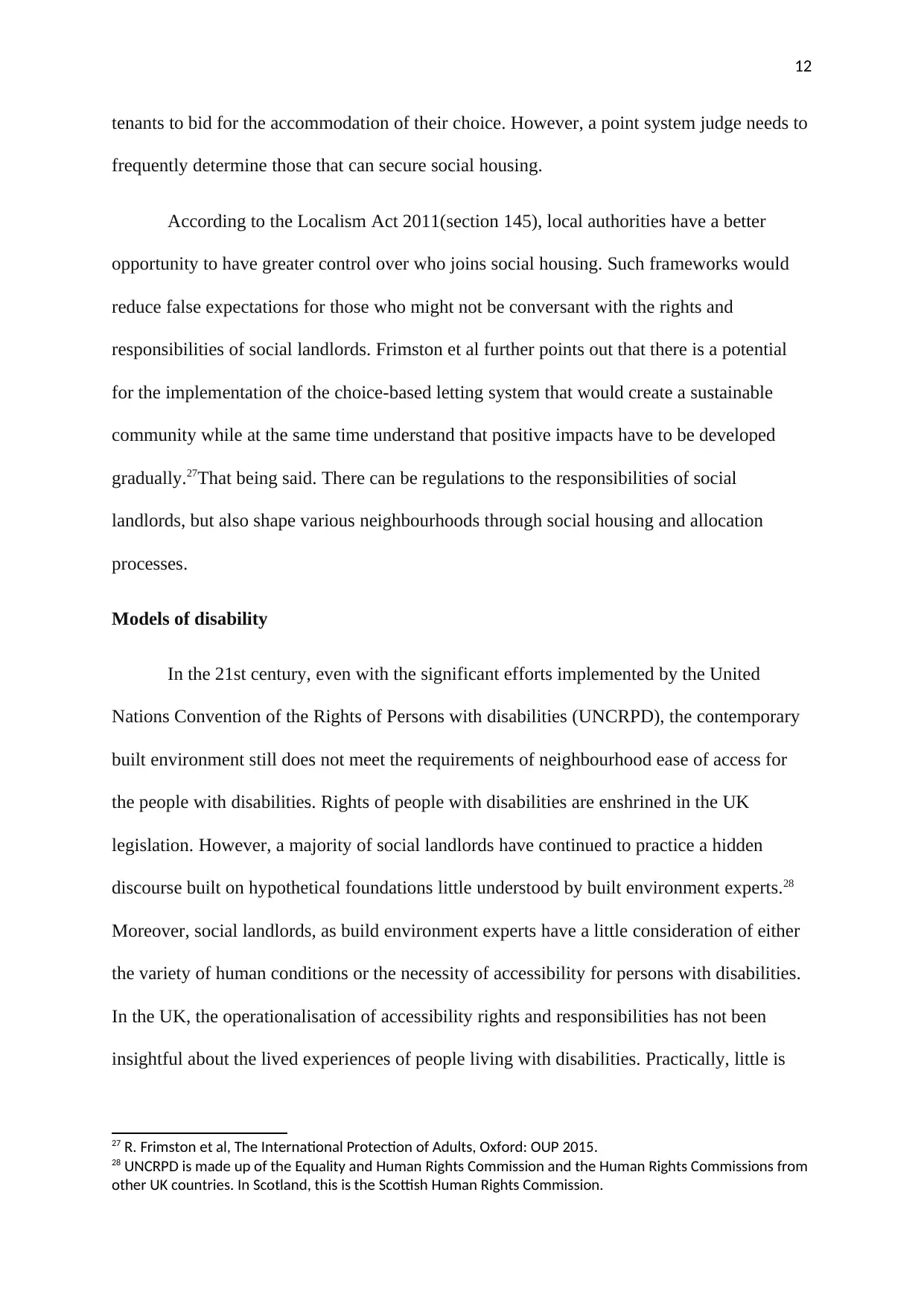
12
tenants to bid for the accommodation of their choice. However, a point system judge needs to
frequently determine those that can secure social housing.
According to the Localism Act 2011(section 145), local authorities have a better
opportunity to have greater control over who joins social housing. Such frameworks would
reduce false expectations for those who might not be conversant with the rights and
responsibilities of social landlords. Frimston et al further points out that there is a potential
for the implementation of the choice-based letting system that would create a sustainable
community while at the same time understand that positive impacts have to be developed
gradually.27That being said. There can be regulations to the responsibilities of social
landlords, but also shape various neighbourhoods through social housing and allocation
processes.
Models of disability
In the 21st century, even with the significant efforts implemented by the United
Nations Convention of the Rights of Persons with disabilities (UNCRPD), the contemporary
built environment still does not meet the requirements of neighbourhood ease of access for
the people with disabilities. Rights of people with disabilities are enshrined in the UK
legislation. However, a majority of social landlords have continued to practice a hidden
discourse built on hypothetical foundations little understood by built environment experts.28
Moreover, social landlords, as build environment experts have a little consideration of either
the variety of human conditions or the necessity of accessibility for persons with disabilities.
In the UK, the operationalisation of accessibility rights and responsibilities has not been
insightful about the lived experiences of people living with disabilities. Practically, little is
27 R. Frimston et al, The International Protection of Adults, Oxford: OUP 2015.
28 UNCRPD is made up of the Equality and Human Rights Commission and the Human Rights Commissions from
other UK countries. In Scotland, this is the Scottish Human Rights Commission.
tenants to bid for the accommodation of their choice. However, a point system judge needs to
frequently determine those that can secure social housing.
According to the Localism Act 2011(section 145), local authorities have a better
opportunity to have greater control over who joins social housing. Such frameworks would
reduce false expectations for those who might not be conversant with the rights and
responsibilities of social landlords. Frimston et al further points out that there is a potential
for the implementation of the choice-based letting system that would create a sustainable
community while at the same time understand that positive impacts have to be developed
gradually.27That being said. There can be regulations to the responsibilities of social
landlords, but also shape various neighbourhoods through social housing and allocation
processes.
Models of disability
In the 21st century, even with the significant efforts implemented by the United
Nations Convention of the Rights of Persons with disabilities (UNCRPD), the contemporary
built environment still does not meet the requirements of neighbourhood ease of access for
the people with disabilities. Rights of people with disabilities are enshrined in the UK
legislation. However, a majority of social landlords have continued to practice a hidden
discourse built on hypothetical foundations little understood by built environment experts.28
Moreover, social landlords, as build environment experts have a little consideration of either
the variety of human conditions or the necessity of accessibility for persons with disabilities.
In the UK, the operationalisation of accessibility rights and responsibilities has not been
insightful about the lived experiences of people living with disabilities. Practically, little is
27 R. Frimston et al, The International Protection of Adults, Oxford: OUP 2015.
28 UNCRPD is made up of the Equality and Human Rights Commission and the Human Rights Commissions from
other UK countries. In Scotland, this is the Scottish Human Rights Commission.
⊘ This is a preview!⊘
Do you want full access?
Subscribe today to unlock all pages.

Trusted by 1+ million students worldwide
1 out of 20
Related Documents
Your All-in-One AI-Powered Toolkit for Academic Success.
+13062052269
info@desklib.com
Available 24*7 on WhatsApp / Email
![[object Object]](/_next/static/media/star-bottom.7253800d.svg)
Unlock your academic potential
Copyright © 2020–2025 A2Z Services. All Rights Reserved. Developed and managed by ZUCOL.





